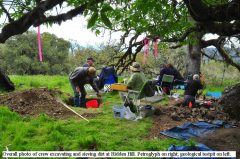
Overall photo of crew excavating and sleving dirt at Hidden Hill. Petroglyph on right ; geological testpit on left.
Theory Behind our Petroglyph Dating
We look for chipped rock art and hammerstone chips that fell to the artist’s feet when the art was made. These chips differ from soil and weathered rock art particles by their larger size and their sharp edges that resulted from hammering. Hammerstone chips are fewer, harder, more resilient and have a different color than rock art chips. To isolate hammerstone chips we first remove disturbed soil under the art, often down to 10 cm, then scrape the soil contents of each successive ¼ inch (6 mm) level over a 8×12 inch (20×30 mm) area into a dustpan. After transferring the contents of each level to nested sieves and shaking them, the few large hammerstone chips and any rootlets are removed from the topmost or ¼ inch (6 mm) mesh sieve. This is done with tweezers to avoid contaminating datable cultural or natural material.
Small hammerstone chips and soil particles pass into a 1.5 mm standard geological sieve or a ca. 10×20 inch building air vent filter of similar mesh available at hardware stores. Tiny chips and bits of organic material for AMS dating are tweezered into separately labeled aluminum foil pouches.
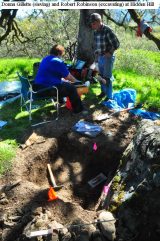
Donna Gillette (sieving) and Robert Robinson (excavating) at Hidden Hill
Most dry soil passing this sieve is discarded as backdirt. As it may mask tiny hammerstone chips, a half cup (125 ml) sample is reserved for later washing and separation into its components. This is done by gravity in a 5 ft. (1.5 m) long water-filled rigid plastic pipe with a test tube attached via a reducing coupler to its base. Hammerstone chips fall ahead of the soil particles and can be removed and confirmed under a lens. Rock art and hammerstone chips in multiple levels represent palimpsests or multiple stages of art production. Dating organic material of natural or cultural origin in the same 6 mm level to these chips should date the art.
Background Data for the Hidden Hill Petroglyph in the HREC
A separate depiction of a cupule, vulva or line series in Old and New World art may date from tens of millennia to several centuries. Cupules alone are widespread in space and time and not discussed here. Along with adjoining triangular vulvas and lines, some circular or oval cupules with raised centers were called PCNs (Pecked Curvilinear Nucleated style) in Teresa Ann Miller’s master’s thesis (1977:44). Their basic style had been noted in Salem Rice’s 1970 report of the Ring Mountain type site, and published by Hotz and Clewlow (1974). Gillette and Hylkema (2009: 275-287) advocated and helped bring California rock art into mainstream archaeology, including PCNs.
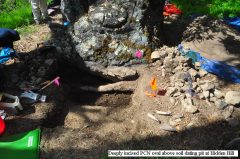
Deeply incised PCN oval above soil dating pit at Hidden Hill
They may be very ancient, their age provable through AMS dating under good stratigraphic conditions in their underlying soil. Their appearance outside California will require more AMS dates and one day we will know their spread. To Gillette’s list of 84 PCNs in the California coast hills (Gillette et al. 1989) can be added those from Oregon, for a count of 120 (Gillette 1998).
Some of the known PCN art include Swallow Rock CA-FRE-2485 in the Diablo Range of western Fresno County near Coalinga, California (Foster and Betts 1994:27-40). It has seven superimposed art styles, each of which should be scientifically dated. But datable material is absent and their report does not describe underlying soil. Their faint Style 2 was California’s oldest and southernmost well-documented PCN occurrence at the time. They believe that most of the central ovals of the deep PCNs were removed to make arrow-shaft straighteners or pendants. Other PCN sites in the Diablo Range include CCO-125, discussed by Miller 1977:22, Fig. 4) and SCL-503 to the south in Henry Coe State Park, covered by Parkman (1986). Gillette (2009) adds several more PCN sites from Julian Steward’s account (1929) and those of others.
Miller said PCNs are on schist boulders near earthquake faults. Such was the case when we tested the deeply carved blue schist Hidden Hill petroglyph in 2011. This MEN-2221 boulder at HREC is located east of the Russian River in southeast Mendocino County in the Mayacamas Mountains (Gillette 1998). It is within traditional Pomo lands where the similar ‘baby stones’ represent a ritual performed by a couple desiring to conceive. Heizer and Clewlow (1973:29-31) estimated ‘baby stone’ age at 350 years, while Parkman 1992:367) said 1450 years. Focusing on what she believes to be the much older PCNs like Hidden Hill, Gillette (2009) wanted to know if they and HREC arrowheads, knives, scrapers, etc., collected by University of California Davis personnel, represent the same time period. An AMS hearth date of 680±40 years, plus dozens of obsidian hydration dates on lithics, show an age range of 150 to 2800 years. Gillette (1998:92; pers. comm. 2011) believes the art is 5,000 to 8,000 years old, which is partly based on Parkman (1993:359) saying it may be Proto-Yukian. Donna Gillette invited us to scientifically AMS date her art because any attempt to fully legitimize PCNs must be based on sound dating.
On-site sampling
After removing surface debris, 6 mm levels over a 8×12 inch (20×30 mm) area below the PCN were scraped into a dustpan down to the palaeosol level at 43 cm. After large hammerstone chips and rootlets were removed from a 6 mm sieve, suitable organic material in this and finer sieves was carefully tweezered into aluminum foil envelopes for future dating. A representative soil sample was bagged for later analysis. Backup samples from 10 to 30 cm layers were taken in a pedological test pit 2 m away.
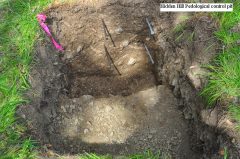
Hidden Hill Pedological control pit
Soil description and examination
As HREC soil is clay-based, meaning most particles were <1µ D, hammerstone and rock art chips encased in clay needed extensive washing and scrubbing before passing through to the next sieve. After these chips and carbon samples were separated, 20-30 ml of a 125 ml of the original soil sample were processed. Again we attempted to remove clay in the sieve, but found that air drying followed by 1.5 mm resieving was more effective. Particles were then immersed in 150 ml of water and emulsified using a hand drink mixer. They were washed onto a paper filter until the water effluent was clear. The cleaned chips were dried and examined under the microscope for shape and material.
Observations at each level
Each sample at 30-33 cm depth revealed <3 sharp and several weathered chips, mainly schist. A sample from 34 cm revealed >12 sharp schist chips >0.5 mm. A sample at 35 cm had no sharp edged chips but did have one sharp 3 mm long piece of quartz crystalline material, possibly a hammerstone chip. Samples from 35-40 cm showed no sharp schist chips. Level 14 at 41 cm revealed >20 sharp schist chips in the 1-2 mm diameter range. Level 15 had a 2 mm diameter seed. Levels at 42-43 cm (lowest level) had no schist chips.
We trowelled quickly through the main test to the paleosol because Donna Gillette believed the PCN element was as old as the paleosol. After finishing, hindsight suggested that I redo the upper profile, so we tested immediately alongside (northwest), beginning at ground level. To avoid confusion, we labeled levels alphabetically. All levels were culturally sterile but level H at 25cm had two unworked chert cobbles (Table 2). While we tested, Mary Gerbic test-shoveled a pedological trench 2.7 m south, where the alluvium was ca. 10 cm thicker (Table 3).
In the final stages of our analyses and prior to sending a sample for dating, we were informed by Donna that a small portion our test area had been excavated earlier. This upset everyone concerned but all decided that the sample atop the paleosol may have been in undisturbed soil 40 cm below surface, especially since both chips and carbonaceous material were associated. As it was also the only level with both fallen chips and organic material, we sent the sample to Beta Analytic for dating.
Results
On July 18, we received an estimate of 130±30 years ago for dating level 14 (Beta-302479), with calibrated 2-sigma dates of AD 1670-1780 (280-160 years ago; Table 1). This was unacceptable and showed that the earlier excavation had gone right to the paleosol. The associated fallen chips and organic material had apparently fallen together when the pit was backfilled. It would be nice to try another undisturbed area if such can be found.
Conclusions
Our identification of rock art and hammerstone chips linked to AMS-datable carbonaceous material under petroglyphs was successful on Gabriola Island, British Columbia, and in the Coso National Monument in central California. It is a viable means of dating artistic periods using undisturbed soil particles. At Hidden Hill this association atop the paleosol proved to be only a century old due to earlier excavation and backfilling. Another Hidden Hill spot or undisturbed site must be found to provide accurate dating of this or similar PCNs. The main criticism of our dating method remains the cost of an AMS date.
Acknowledgements
I thank field crew members Midge Gordon, Mary Gerbic, Donna and Gary Gillette and Robert Robinson. For laboratory work I thank Don Gribble for extensive soil sample filtering and purification, Alicia Ghadban for editing, and Spencer Sutton for website adaptation.
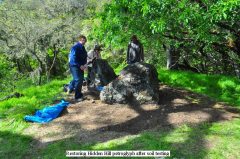
Restoring Hidden Hill petroglyph after soil testing
Bibliography
Foster, Daniel G. and John Betts 1994. Swallow Rock (CA-FRE-2485): An outstanding petroglyph site in the southern Diablo Range, Fresno County, California. Rock Art Papers, Volume 11 (ed. By Ken Hedges). San Diego Museum Paper 31.
Gillette, Donna L. 1998. PCN’s of the Coast Ranges of California: Religious expression of the result of quarrying? M.A. thesis, Dept. of Anthropology, California State University, Hayward.
-2009. Bones, stones, and cultural markings: A contextual approach through testing provided by the Bennyhoff Award. South California Archaeological Proceedings, Vol. 22.
Gillette, Donna L. and Reed Haslem 1989. A stylistic analysis of the rock art of CA-SBN-12. Proceedings of the Society for California Archaeology 12:134-139.
Gillette, Donna L. and Linda Hylkema. 2009. Pecking away the bias: Incorporating California rock art into mainstream archaeology. Proceedings of the Society for California Archaeology 21:275-287.
Heizer, Robert F. and C. William Clewlow, Jr. 1973. Prehistoric rock art of California (2 vols.). Ballena Press, Ramona, CA.
Hotz, Virginia and J. Clewlow 1974. A northern California petroglyph site. The Masterkey 48(4):148-152.
Miller, Teresa Ann 1977. Identification and recording of prehistoric petroglyphs in Marin and related Bay area counties. MA thesis. San Francisco State University.
Parkman, E. Breck 1986. Cupule petroglyphs in the Diablo Range, California. J. California and Great Basin Archaeology 8(2):246-259.
-1992. Toward a Proto-Hokan ideology. IN Ancient images, ancient thought: The archaeology of ideology. (ed. By A.S. Goldsmith, S. Garvie, D. Stein & J. Smith). Pp. 365-370. University of Calgary.
-1993. Creating thunder: The Western rain-making process. J. California and Great Basin Archaeology 15(1):90-110.
Steward, Julian H. 1929. Petroglyphs of California and adjoining states. University of California Publications in ArchaeologyBibliography
Foster, Daniel G. and John Betts 1994. Swallow Rock (CA-FRE-2485): An outstanding petroglyph site in the southern Diablo Range, Fresno County, California. Rock Art Papers, Volume 11 (ed. By Ken Hedges). San Diego Museum Paper 31.
Gillette, Donna L. 1998. PCN’s of the Coast Ranges of California: Religious expression of the result of quarrying? M.A. thesis, Dept. of Anthropology, California State University, Hayward.
-2009. Bones, stones, and cultural markings: A contextual approach through testing provided by the Bennyhoff Award. South California Archaeological Proceedings, Vol. 22.
Gillette, Donna L. and Reed Haslem 1989. A stylistic analysis of the rock art of CA-SBN-12. Proceedings of the Society for California Archaeology 12:134-139.
Gillette, Donna L. and Linda Hylkema. 2009. Pecking away the bias: Incorporating California rock art into mainstream archaeology. Proceedings of the Society for California Archaeology 21:275-287.
Heizer, Robert F. and C. William Clewlow, Jr. 1973. Prehistoric rock art of California (2 vols.). Ballena Press, Ramona, CA.
Hotz, Virginia and J. Clewlow 1974. A northern California petroglyph site. The Masterkey 48(4):148-152.
Miller, Teresa Ann 1977. Identification and recording of prehistoric petroglyphs in Marin and related Bay area counties. MA thesis. San Francisco State University.
Parkman, E. Breck 1986. Cupule petroglyphs in the Diablo Range, California. J. California and Great Basin Archaeology 8(2):246-259.
-1992. Toward a Proto-Hokan ideology. IN Ancient images, ancient thought: The archaeology of ideology. (ed. By A.S. Goldsmith, S. Garvie, D. Stein & J. Smith). Pp. 365-370. University of Calgary.
-1993. Creating thunder: The Western rain-making process. J. California and Great Basin Archaeology 15(1):90-110.
Steward, Julian H. 1929. Petroglyphs of California and adjoining states. University of California Publications in Archaeology